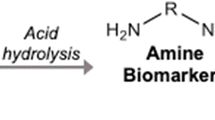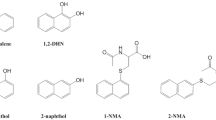Abstract
The occupational exposure of 19 men to hexamethylene diisocyanate (HDI) vapour was monitored during one 8-h shift. It ranged from 0.30 to 97.7 μg/m3. This was compared with the urinary output of hexane diamine (HDA) liberated by acid hydrolysis from its conjugates in post-shift samples. The excretion varied from 1.36 to 27.7 μg/g creatinine, and there was a linear association of HDI air concentration with urinary HDA excretion. The validity of the urinary analysis was confirmed by simultaneous blind analysis in another laboratory. The results had an excellent linear concordance. Thus, it seems that while the gas chromatographic-mass spectrometric detection method requires sophisticated apparatus, the results are very useful to occupational health practices. A biological exposure index limit of 19 μg HDA/g creatinine in a post-shift urine specimen is proposed as an occupational limit level of HDI monomer (time-weighted average=75 μg/m3). Most importantly, biological monitoring of HDA is sensitive enough to be used at and below the current allowable exposure limit levels.
Similar content being viewed by others
References
Berode M, Testa B, Savolainen H (1991) Bicarbonate-catalyzed hydrolysis of hexamethylene diisocyanate to 1,6-diaminohexane. Toxicol Lett 56:173–178
Brorson T, Skarping G, Nielsen J (1990) Biological monitoring of isocyanates and related amines. II. Test chamber exposure of humans to 1,6-hexamethylene diisocyanate (HDI). Int Arch Occup Environ Health 62:385–389
Brorson T, Skarping G, Sandström JF, Stenberg M (1990) Biological monitoring of isocyanates and related amines. I. Determination of 1,6-hexamethylene diamine (HDA) in hydrolysed human urine after oral administration of HDA. Int Arch Occup Environ Health 62:79–84
Dalene M, Skarping G, Tinnerberg H (1994) Biological monitoring of hexamethylene diisocyanate by determination of 1,6-hexamethylene diamine as the trifluoroethyl chloroformate derivative using capillary gas chromatography with thermoionic and selective-ion monitoring. J Chromatogr B Biomed Appl 656:319–328
Diller WF (1991) Arbeitsmedizinische Gesichtspunkte bei der Begutachtung des «Isocyanat-Asthmas». Arbeitsmed Sozialmed Präventivmed 26:393–398
Ferguson JS, Schaper M, Alarie Y (1987) Pulmonary effects of polyisocyanate aerosol: hexamethylene diisocyanate trimer (HDIt) or desmodur-N (DES-N). Toxicol Appl Pharmacol 89:332–346
Huynh CK, Vu-Duc T, Savolainen H (1992) Design and evaluation of a solid sampler for monitoring of airborne 1,6-hexamethylene diisocyanate and its prepolymers in two-component spray painting. Am Ind Hyg Assoc J 53:157–162
Kennedy AL, Wilson TR, Stock MF, Alarie Y, Brown WE (1994) Distribution and reactivity of inhaled14C-labeled toluene diisocyanate (TDI) in rats. Arch Toxicol 68:434–443
Maître A, Berode M, Perdrix A, Romazini S, Savolainen H (1993) Biolgoical monitoring of occupational exposure to toluene diisocyanate. Int Arch Occup Environ Health 65:97–100
Maître A, Leplay A, Perdrix A, Ohl G, Boinay P, Romazini S, Aubrun JC (1996) Comparison between solid sampler and impinger for evaluation of occupational exposure to 1,6 hexamethylene diisocyanate polyisocyanates during spray painting. Am Ind Hyg Assoc J 57:153–160
Parker DL, Waller K, Himrich B, Martinez A, Martin F (1991) A cross-sectional study of pulmonary function in auto repair workers. Am J Public Health 81:768–771
Persson P, Dalene M, Skarping G, Adamsson M, Hagmar L (1993) Biological monitoring or occupational exposure to toluene diisocyanate: measurement of toluenediamine in hydrolysed urine and plasma by gas chromatography-mass spectrometry. B J Ind Med 50:1111–1118
Rosenberg C, Savolainen H (1986) Determination in urine of diisocyanate-derived amines from occupational exposure by gas chromatography-mass fragmentography. Analyst 111: 1069–1071
Timchalk C, Smith FA, Bartels MJ (1994) Route-dependent comparative metabolism of (14C)toluene 2,4-diisocyanate and (14C)toluene 2,4-diamine in Fischer 344 rats. Toxicol Appl Pharmacol 124:181–190
Tornling G, Alexandersson R, Hedenstierna G, Plato N (1990) Decreased lung function and exposure to diisocyanates (HDI and HDI-BT) in car repair painters: Observations on re-examination 6 years after the initial study. Am J Ind Med 17:299–310
Vandenplass O, Cartier A, Lesage J, Cloutier Y, Perreault G, Grammer LC, Shaughnessy MA, Malo JL (1993) Prepolymers of hexamethylene diisocyanate as a cause of occupational asthma. J Allergy Clin Immunol 91:850–861
Zhao CJ, Kobashi K (1992) Urethanase in rat tissues. J Toxicol Environ Health 37:37–45
Author information
Authors and Affiliations
Rights and permissions
About this article
Cite this article
Maître, A., Berode, M., Perdrix, A. et al. Urinary hexane diamine as an indicator of occupational exposure to hexamethylene diisocyanate. Int. Arch Occup Environ Heath 69, 65–68 (1996). https://doi.org/10.1007/BF02630741
Received:
Accepted:
Issue Date:
DOI: https://doi.org/10.1007/BF02630741




